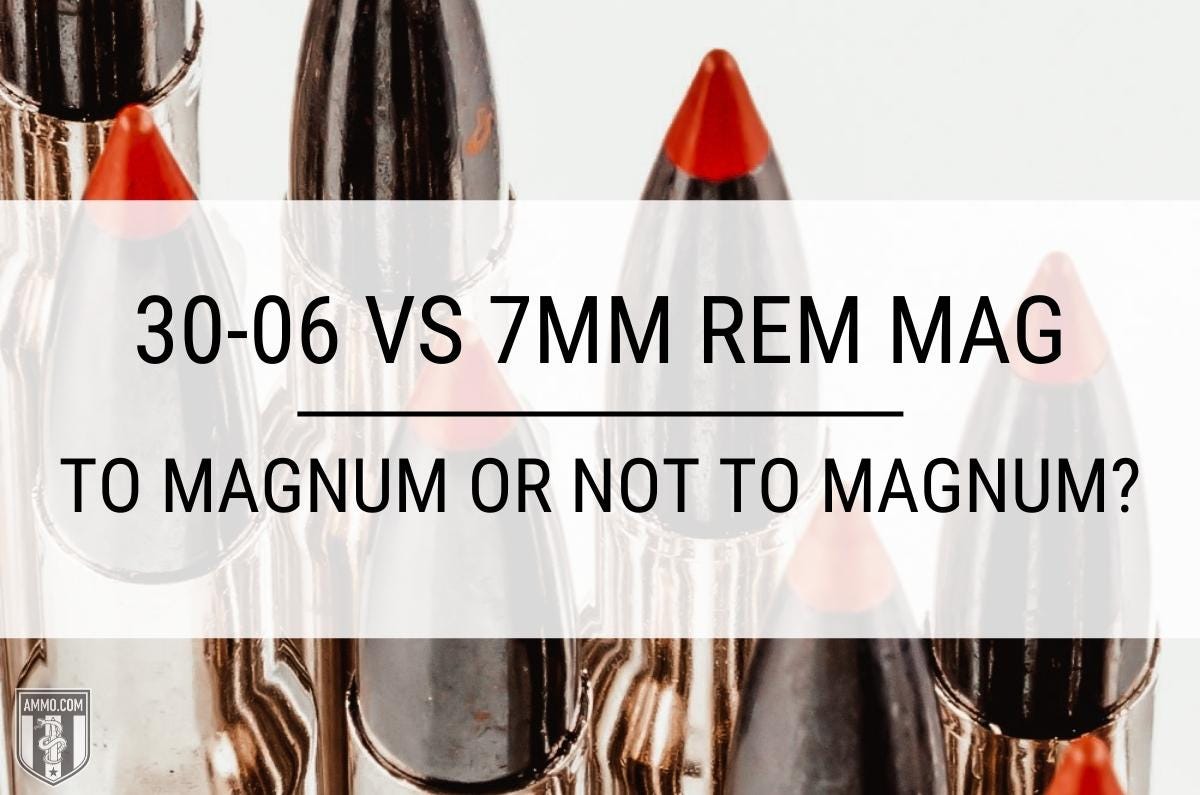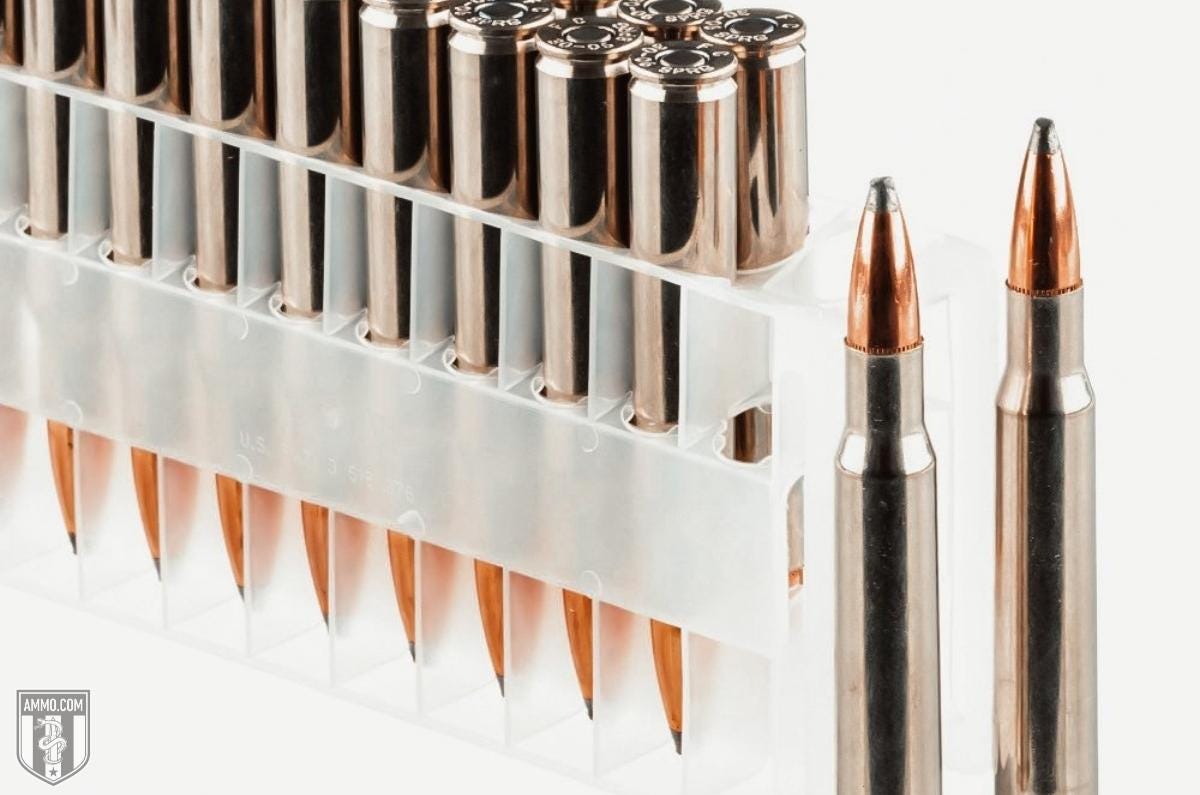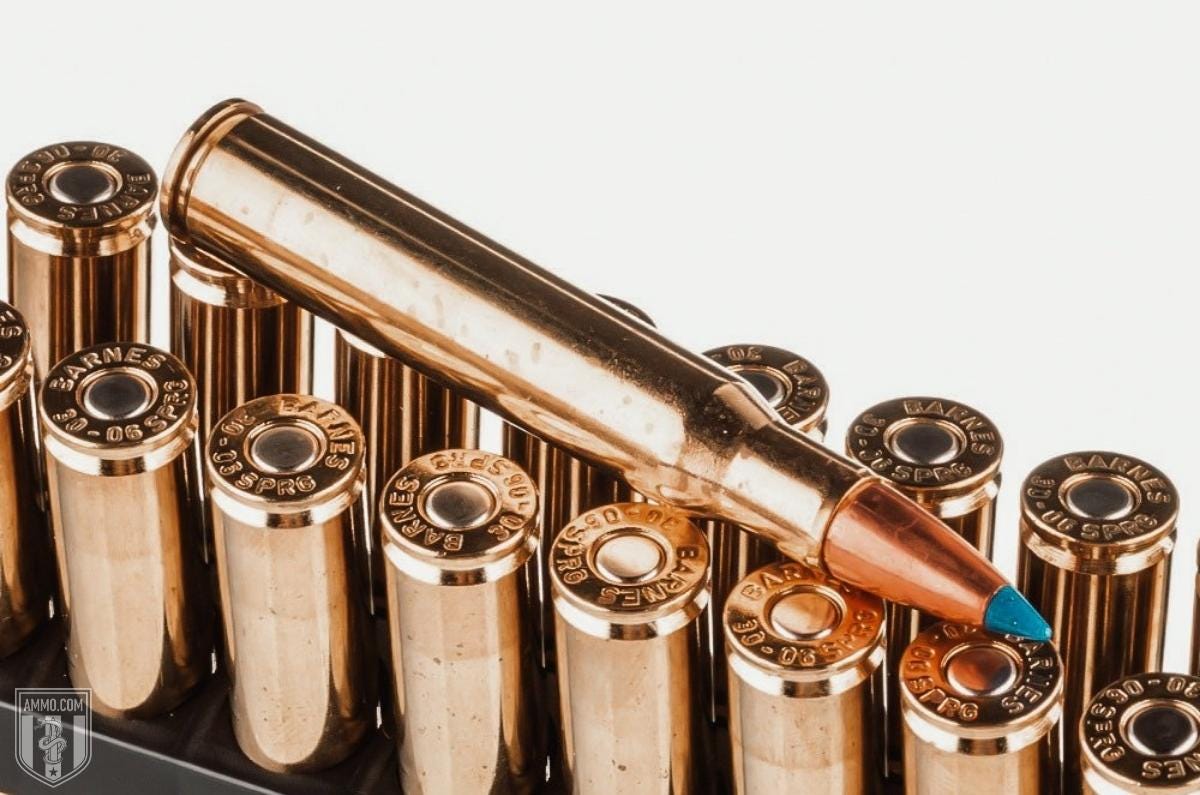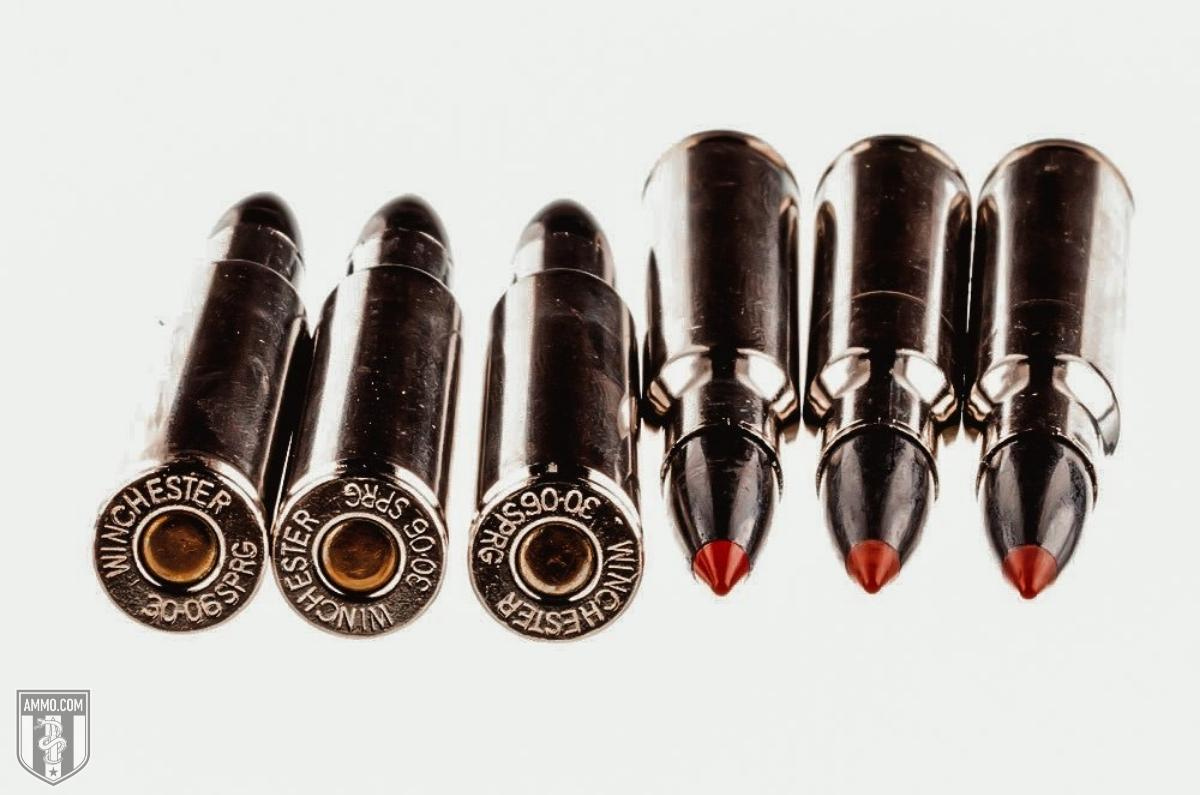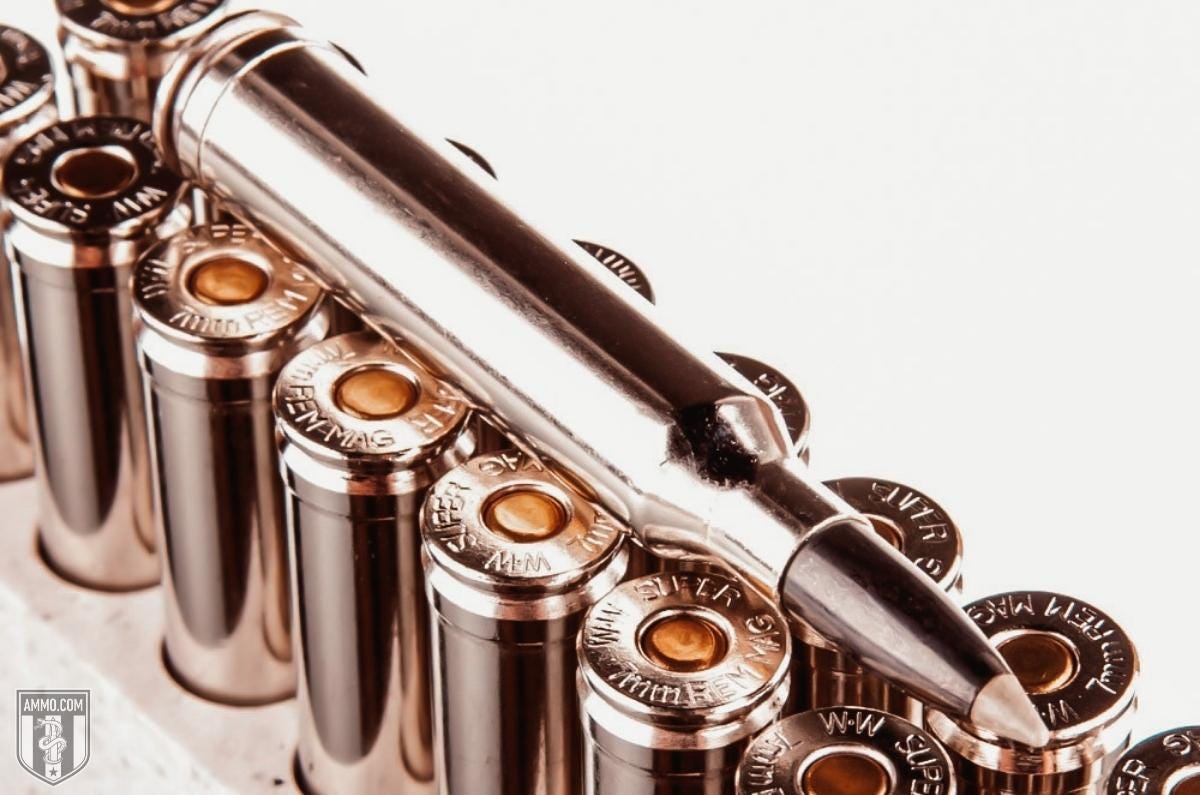30-06 vs 7mm Rem Mag: To Magnum or Not to Magnum?
The 30-06 vs 7mm Rem Mag is a hunting cartridge debate that rages on hunting forms to this day. Do the ballistics of 7mm Remington Magnum make it the top dog?
As Hamlet the Hunter lifted his deer skull trophy towards the heavens, he posed this missive to the universe, “To magnum or not to magnum? This is the question!”
When it comes to terminal performance on medium to big game animals, it is hard to beat the effectiveness of the 30-06 Springfield and the 7mm Remington Magnum.
Both are extremely popular with sportsmen across North America and make an excellent choice for your new hunting rifle.
However, there has been exhaustive debate at gun counters, campfires, and online forums as to which of these two hunting cartridges is superior.
It’s a debate of hair-splitting details and truly comes down to your preference as a hunter or long-range shooter.
In this article, we will break down the advantages and disadvantages of each rifle cartridge to help you make an informed decision on your next hunting rifle purchase.
What is the Difference Between 30-06 and a 7mm?
The 30-06 Springfield has been one of the most popular rifle cartridges across North America since its introduction in 1906 and is the gold standard by which all other hunting cartridges are measured. One does not need to look far on any online gun forums to see retorts like, “But is it better than a 30-06?”
As the US military’s primary rifle cartridge for WWI, WWII, and the Korean War, the 30-06 has proven its effectiveness against 2-legged and 4-legged varmints across 6 continents and over a century of service to soldiers and sportsmen alike.
The 7mm Remington Magnum was Remington’s addition to the belted magnum craze of the 1960s and was specifically designed as a sporting cartridge. Due to its design, the 7mm can fire the same popular bullet weights as the 30-06, but it does so with higher FPS at the muzzle, more ft-lbs of energy, and can retain those ballistic advantages at longer ranges.
From a bird’s eye view, it seems as though the 7mm Rem Mag outperforms the 30-06 in virtually every ballistic category, but why then does the 30-06 remain one of the most popular sporting cartridges on the market?
In the following sections, we will thoroughly examine the differences between these two cartridges and explain why some hunters prefer the old 30-06 warhorse over the ballistically superior 7mm Rem Mag.
Cartridge Specs
When evaluating two big game hunting cartridges, it’s a good idea to analyze the cartridge specs to gain more knowledge of each.
The first, and most obvious difference, is that each cartridge fires a different caliber bullet. The 30-06, as you might guess, fires 30-caliber or 0.308” diameter bullets while the 7mm Rem Mag fires 0.284” diameter bullets (7.2mm).
While the case length for the 30-06 is only 0.006” shorter than the 7mm, the case capacity is quite different between the two. The 30-06 can accommodate a respectful 68 grains of powder while the 7mm Rem Mag is packing a massive 82 grains of case capacity.
This difference in case capacity is due to the 7mm RM being a wider cartridge with a 0.512” base diameter. This wider base requires the use of a magnum bolt face, however, the overall length of the 7mm is 0.05” shorter than the 30-06, which means the 7mm Rem Mag can fit in a standard action receiver.
The 7mm Remington Magnum can also accommodate slightly higher SAAMI max pressures at 61,000 psi compared to 60,200 psi for the 30-06
Recoil
Recoil is the energy directed towards the shooter when a cartridge is fired from a firearm. For experienced hunters or marksmen, recoil will be a non-issue. However, for less experienced shooters or those who are recoil sensitive, less recoil will be preferred.
Lower recoil will also allow shooters to get their sights back on target quicker for follow-up shots. In contrast, heavy recoil can cause shooters to flinch before they pull the trigger, and during long-range shooting sessions, shoulder fatigue can become an issue.
On average, the 7mm Rem Mag will have about 28 ft-lbs of felt recoil, while the 30-06 will have less recoil with an average of 23 ft-lbs.
In terms of real-world experience, this is not a significant difference and the added recoil of the 7mm can easily be mitigated by using a muzzle brake or a recoil pad. Generally speaking, the 7mm RM is a fairly light recoiling magnum round when compared to the 300 Win Mag or the 300 WSM.
The 30-06 will generally have less recoil than the 7mm Rem Mag.
Trajectory
Trajectory is how we quantify a bullet’s flight path as it travels downrange measured in inches of bullet drop.
Having a flat shooting cartridge is preferred for shooting longer ranges as a shooter will have to make fewer adjustments to their optics to compensate for bullet drop. Having a flatter trajectory also means that a cartridge will be more forgiving of ranging mistakes.
At shorter ranges (under 400 yards), both rifle cartridges have virtually identical trajectories. However, once you start shooting 400-1,000 yards, the difference in trajectory becomes apparent.
At 500 yards, the 30-06 has experienced an average of -48” of bullet drop while the 7mm Rem Mag has dropped -38”. Some proponents of the 30-06 might contest that 10” isn’t all that much, but that could easily be the difference between a double-lung shot and grazing the belly of the prize whitetail or mule deer you’ve been staling all day.
At 1,000 yards the flat shooting 7mm RM really shines, as it has dropped -287” compared to -398” for the 30-06 Springfield.
For long-range shooting, the 7mm Remington Magnum clearly has a flatter trajectory and is the superior choice.
Ballistic Coefficient
Ballistic coefficient (BC) is a measure of how well a bullet resists wind drift and air resistance. Put another way, it’s a numeric representation of how aerodynamic a bullet is. A high BC is preferred as this means the bullet will buck the wind easier.
Generally, heavier bullets will have a higher BC as it takes more force to disrupt the flight of a heavier bullet than a lighter one.
Ballistic coefficient varies from bullet to bullet based on design, weight, and other factors that are beyond the scope of this article.
However, the 7mm Rem Mag generally will have a slight edge over the 30-06 in terms of BC. Several excellent offerings in 7mm RM would be the Hornady Superformance 162 gr, having a BC of 0.55, and the Berger Trophy Gold VLD 168 gr, with a BC of 0.618.
Some top performers for the 30-06 include the Nosler AccuBond 200 gr with a BC of 0.50 and the Federal Gold Medal Match 168 gr at 0.463.
This does not detract from the 30-06 in any way, as anything with a BC over 0.40 is considered very good. However, the 7mm RM is just better in terms of ballistic coefficient as it can fire the more slender, aerodynamic bullets at higher muzzle velocity which aids in resisting wind drift.
Sectional Density
Sectional Density (SD) is the measure of how well a bullet penetrates a target. This is extremely important when hunting big game, as you need a bullet that can punch through thick hide, bone, and sinew.
Sectional density is calculated by comparing the bullet weight and the bullet diameter. The higher the SD the deeper the bullet will penetrate the target.
This is a simplified view of penetration as there are other factors to consider, such as bullet expansion and velocity.
The 200 gr Nosler Accubond for the 30-06 continues to perform extremely well and has a SD of 0.301, while the Winchester Expedition Big Game 168 gr 7mm RM has a SD of 0.298.
Although there can be variation in SD between bullet weights and design, there is not a significant difference in sectional density between 7mm and 30-06. And it is extremely unlikely that a hunter, whitetail, antelope, or mule deer will be able to detect any noticeable difference between the two.
Hunting
When comparing rifle cartridges for your next hunting rifle, it’s important to look at all the different variables between the two.
The 30-06 shoots larger diameter bullets with about 18% more frontal surface area than the 7mm, meaning the 30-06 will create a larger permanent wound channel. However, the 7mm Rem Mag will have slightly higher muzzle velocity and retain its kinetic energy more efficiently over longer ranges.
Furthermore, the 7mm will generally have a flatter trajectory and resist wind drift better than similarly weighted bullets fired from the 30-06, though the 30-06 will have a lower recoil impulse. Slightly higher sectional density ratings also help the 7mm Rem Mag hit above its weight class like the 7x57mm Mauser or 270 Winchester.
Both hunting cartridges are extremely versatile, with lightweight bullets for varmints to heavyweight options for elk and bears.
Many internet hunting forums are ablaze with controversy over which of these rifle cartridges are superior. But the truth is that we are simply splitting hairs here.
In any real-world hunting scenario at ethical ranges, there’s no deer, elk, moose, or bear across North America that will be able to tell the difference between the 30-06 and the 7mm Rem Mag. So long as your shot placement is on point, both cartridges will serve you well.
Ammo/Rifle Cost and Availability
In terms of rifle availability, both the 30-06 and 7mm Remington Magnum have a multitude of options available. Most models are bolt-action rifles as hunters and marksmen aim for high levels of accuracy with both cartridges.
Some popular hunting rifles include:
Savage 110 Hunter
Winchester Model 70
Tikka T3
Remington 700
Weatherby Vanguard
In terms of semi-auto rifles, the Browning BAR is available in both calibers, however, the venerable M1 Garand is also an option for 30-06.
If you’re looking for a hunting rifle with some character, you might enjoy a military surplus rifle. The 30-06 has several surplus options, such as the 1903 Springfield and rebarreled Mauser rifles, which are relatively easy to come by on the secondary market.
In terms of rifle cost, new production rifles for 30-06 and 7mm RM will be essentially identical. Surplus military rifles will generally be less expensive, but it’s getting harder and harder to get your hands on a reasonably priced CMP field grade M1 Garand.
One other consideration is rifle weight and barrel length. One downside of the 7mm RM is that it requires nothing less than a 24-26” barrel to reach its full potential as a cartridge, while the 30-06 can perform at peak levels using a 22” barrel. A shorter barrel will be more maneuverable in heavy brush and will also weigh less, making it easier to carry on long stalks or hikes.
In general, a 30-06 hunting rifle will be lighter and shorter than its 7mm Rem Mag counterpart, giving the 30-06 a slight edge in this category.
In terms of factory loads, it’s hard to beat the variety of ammo offered for 30-06. Since it was a military round for multiple decades, there have been extensive advancements and developments surrounding America’s iconic 30-caliber rifle cartridge.
The 7mm is not lacking in options by any stretch of the imagination, there are just simply more for 30-06.
The 30-06’s popularity also lead to lower cost per round as cheap practice ammo can be had for as low as $1.30/round while premium hunting ammo, like Barnes VOR-TX, will cost upwards of $3.00/round.
Speaking of ammo price make sure to check out our stock of Hornady 30-06 ammo and Remington .30-06 ammo for more options.
Although not as common, ammo for 7mm Rem Mag is not prohibitively expensive. Practice ammo typically runs around $1.70/round and premium hunting rounds, like Sierra GameChanger or Federal Premium Terminal Ascent 7mm Rem Mag ammo, will hit your wallet for about $4/round.
Every gun shop and sporting goods store across North America will have 30-06 ammo on the shelves. And although the 7mm Rem Mag is still a popular cartridge, it might be difficult to find factory loads in smaller stores as it is less popular than the 30-06.
Reloading
One way to reduce your overall cost per round is to handload your own ammo. This allows you to customize your ammo to match your rifle, creating extremely accurate and consistent rounds.
In terms of reloading the 30-06, it is perhaps one of the most frequently handloaded cartridges on the North American continent. There is a plethora of different bullet weights and profiles available from all the major bullet manufacturers like Sierra, Hornady, Barnes, Berger, and Nosler.
The 0.308” diameter bullet is extremely popular and is used for reloading 308 Winchester, 300 Win Mag, and 300 WSM, just to name a few.
One tricky aspect of reloading 7mm Rem Mag is recognizing that it doesn’t fire a true 7mm bullet. The bullet diameter for 7mm RM is 0.284” or 7.2mm, and this limits the cartridges that share bullet cross-compatibility. Those cartridges that fire a 0.284” diameter bullets include the 280 Remington, 7mm-08, 7mm WSM, 7mm Weatherby Magnum, and the .284 Winchester.
Although less popular, all the major bullet manufacturers will have offerings for 0.284” diameter bullets, just not as many as for 30-caliber.
Magnum power or classic precision? 🦌 Uncover which cartridge suits your hunt!
Read more here 👉 30-06 vs 7mm Rem Mag: To Magnum or Not to Magnum?




